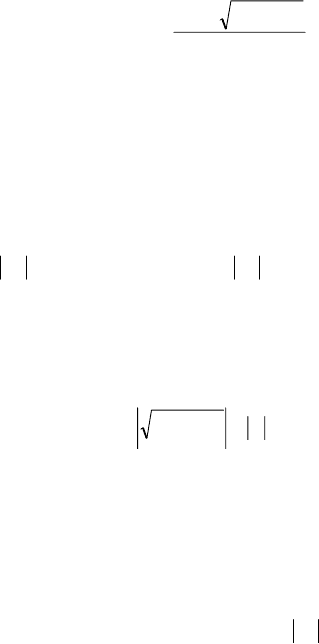El-Hawary M.E. Electrical Energy Systems
Подождите немного. Документ загружается.


316
© 2000 CRC Press LLC
=
4
3
2
1
bus
V
V
V
V
V
The admittance matrix is defined as
=
44342414
34332313
24232212
14131211
bus
YYYY
YYYY
YYYY
YYYY
Y
We note that the bus admittance matrix
Y
bus
is symmetric.
The General Form of the Load-Flow Equations
The result obtained for the 4 bus network can be generalized to the case
of n buses. Here, each of vectors
I
bus
and
V
bus
are n
×
1 vectors. The bus
admittance matrix becomes and n
×
n matrix with elements
ij
Ljiij
YYY
−==
(8.2)
∑
=
=
n
j
Lii
ij
YY
0
(8.3)
The summation is over the set of all buses connected to bus i including the
ground (node 0).
We recall that bus powers S
i
rather than the bus currents I
i
are, in
practice, specified. We thus use
i
i
i
V
S
I
=
*
As a result, we have
()
∑
=
=
−
n
j
jij
i
ii
VY
V
jQP
1
*
()
ni ,,1
=
(8.4)
These are the static power flow equations. Each equation is complex, and
therefore we have 2n real equations.

317
© 2000 CRC Press LLC
The nodal admittance matrix current equation can be written in the
power form:
()
()
∑
=
=−
n
j
jijiii
VYVjQP
1
*
(8.5)
The bus voltages on the right-hand side can be substituted for using
either the rectangular form:
1
jfeV
ii
+=
or the polar form:
ii
j
ii
V
ieVV
θ
θ
∠=
=
Rectangular Form
If we choose the rectangular form, then we have by substitution,
()()
++
−=
∑∑
==
n
j
iijjiji
n
j
iijjijii
eBfGffBeGeP
11
(8.6)
()()
+−
−=
∑∑
==
n
j
iijjiji
n
j
iijjijii
eBfGefBeGfQ
11
(8.7)
where the admittance is expressed in the rectangular form:
ijijij
jBGY
+=
(8.8)
Polar Form
On the other hand, if we choose the polar form, then we have
()
ijjij
n
j
ijii
VYVP
ψθθ
−−=
∑
=
cos
1
(8.9)
()
ijjij
n
j
ijii
VYVQ
ψθθ
−−=
∑
=
sin
1
(8.10)

318
© 2000 CRC Press LLC
where the admittance is expressed in the polar form:
ijijij
YY
ψ
∠=
(8.11)
Hybrid Form
An alternative form of the power flow equations is the hybrid form,
which is essentially the polar form with the admittances expressed in rectangular
form. Expanding the trigonometric functions, we have
() ()
[]
ijjiijjij
n
j
ijii
VYVP
ψθθψθθ
sinsincoscos
1
−+−=
∑
=
(8.12)
() ()
[]
ijjiijjij
n
j
ijii
VYVQ
ψθθψθθ
sincoscossin
1
−−−=
∑
=
(8.13)
Now we use
()
ijij
ijijijij
jBG
jYY
+=
+=
ψψ
sincos
(8.14)
Separating the real and imaginary parts, we obtain
ijijij
YG
ψ
cos
=
(8.15)
ijijij
YB
ψ
sin
=
(8.16)
so that the power-flow equations reduce to
() ()
[]
∑
=
−+−=
n
j
jiijjiijjii
BGVVP
1
sincos
θθθθ
(8.17)
() ()
[]
∑
=
−−−=
n
j
jiijjiijjii
BGVVQ
1
cossin
θθθθ
(8.18)
The Power Flow Problem
The power-flow (or load-flow) problem is concerned with finding the
static operating conditions of an electric power transmission system while
satisfying constraints specified for power and/or voltage at the network buses.

319
© 2000 CRC Press LLC
Generally, buses are classified as follows:
1. A load bus (P-Q bus) is one at which S
i
= P
i
+jQ
i
is specified.
2. A generator bus (P-V bus) is a bus with specified injected active
power and a fixed voltage magnitude.
3. A system reference or slack (swing) bus is one at which both the
magnitude and phase angle of the voltage are specified. It is
customary to choose one of the available P-V buses as slack and to
regard its active power as the unknown.
As we have seen before, each bus is modeled by two equations. In all,
we have 2n equations in 2n unknowns. These are
V
and
θ
at the load buses, Q
and
θ
at the generator buses, and the P and Q at the slack bus.
Let us emphasize here that due to the bus classifications, it is not
necessary for us to solve the 2n equations simultaneously. A reduction in the
required number of equations can be effected. What we do essentially is to
designate the unknown voltage magnitudes
i
V
and angles
θ
i
at load buses and
θ
i
at generator buses as primary unknowns. Once these values are obtained, then
we can evaluate the secondary unknowns P
i
and Q
i
at the slack bus and the
reactive powers for the generator buses. This leads us to specifying the
necessary equations for a full solution:
1. At load buses, two equations for active and reactive powers are
needed.
2. At generator buses, with
j
V specified, only the active power
equation is needed.
Nonlinearity of the Power Flow Problem
Consider the power flow problem for a two-bus system with bus 1
being the reference bus and bus 2 is the load bus. The unknown is
2
V
, and is
replaced by x.
2
Vx
=
2
22
Y
=
α
(8.19)
()
2
12
sp
2
22
sp
2
22
2 YPGQB
−−=
β
(8.20)
()
2
sp
2
S
=
γ
(8.21)

320
© 2000 CRC Press LLC
()()()
2
sp
2
2
sp
2
2
sp
2
QPS
+=
(8.22)
We can demonstrate that the power flow equations reduce to the following
equation:
0
24
=++
γβα
xx
(8.23)
The solution to the fourth order equation is straightforward since we
can solve first for x
2
as
α
αγββ
2
4
2
2
−±−
=
x
(8.24)
Since x
2
cannot be imaginary, we have a first condition requiring that
04
2
≥−
αγβ
From the definitions of
α
,
β
, and
γ
, we can show that for a meaningful solution
to exist, we need to satisfy the condition:
()()
−++≥
sp
2
22
sp
2
22
2
12
2
sp
2
22
sp
2
22
4
12
4 QGPBYQGPBY
(8.25)
A second condition can be obtained if we observe that x cannot be
imaginary, requiring that x
2
be positive. Observing that
α
and
γ
are positive by
their definition leads us to conclude that
βαγβ
≤−
4
2
For x
2
to be positive, we need
0
≤
β
or
()
02
2
12
sp
2
22
sp
2
22
≤−−
YPGQB
(8.26)
We can therefore conclude the following:
•
There may be some specified operating conditions for which no
solution exists.
•
More than one solution can exist. The choice can be narrowed
down to a practical answer using further considerations.

321
© 2000 CRC Press LLC
Except for very simple networks, the load-flow problem results in a set of
simultaneous algebraic equations that cannot be solved in closed form. It is
necessary to employ numerical iterative techniques that start by assuming a set
of values of the unknowns and then repeatedly improve on their values in an
organized fashion until (hopefully) a solution satisfying the power flow
equations is reached. The next section considers the question of getting
estimates (initial guess) for the unknowns.
Generating Initial Guess Solution
It is important to have a good approximation to the load-flow solution,
which is then used as a starting estimate (or initial guess) in the iterative
procedure. A fairly simple process can be used to evaluate a good
approximation to the unknown voltages and phase angles. The process is
implemented in two stages: the first calculates the approximate angles, and the
second calculates the approximate voltage magnitudes.
Busbar Voltage Angles Approximation
In this stage we make the following assumptions:
1. All angles are small, so that sin
θ
≅
θ
, cos
θ
≅
1.
2. All voltage magnitudes are 1 p.u.
Applying these assumptions to the active power equations for the
generator buses and load buses in hybrid form, we obtain
() ( )
jiij
N
j
iji
BGP
θθ
−+=
∑
=
1
This is a system of N-1 simultaneous linear equations in
θ
i
, which is then solved
to obtain the busbar voltage angle approximations.
Busbar Voltage Magnitude Approximation
The calculation of voltage magnitudes employs the angles provided by the
above procedure. The calculation is needed only for load buses. We represent
each unknown voltage magnitude as
ii
VV
∆+=
1
We also assume that
i
i
V
V
∆−≅
∆+
1
1
1

322
© 2000 CRC Press LLC
By considering all load buses we obtain a linear system of simultaneous
equations in the unknowns
i
V
∆
. The results are much more reliable than the
commonly used flat-start process where all voltages are assumed to be 01
∠
.
Newton-Raphson Method
The Newton-Raphson (NR) method is widely used for solving
nonlinear equations. It transforms the original nonlinear problem into a
sequence of linear problems whose solutions approach the solution of the
original problem. The method can be applied to one equation in one unknown or
to a system of simultaneous equations with as many unknowns as equations.
One-Dimensional Case
Let F(x) be a nonlinear equation. Any value of x that satisfies F(x) = 0
is a root of F(x). To find a particular root, an initial guess for x in the vicinity of
the root is needed. Let this initial guess by x
0
. Thus
00
)( FxF
∆=
where
∆
F
0
is the error since x
0
is not a root. A tangent is drawn at the point on
the curve corresponding to x
0
, and is projected until it intercepts the x-axis to
determine a second estimate of the root. Again the derivative is evaluated, and a
tangent line is formed to proceed to the third estimate of x. The line generated
in this process is given by
))(()()(
nnn
xxxFxFxy
−
′
+=
(8.27)
which, when y(x) = 0, gives the recursion formula for iterative estimates of the
root:
()
()
n
n
nn
xF
xF
xx
′
−=
+
1
(8.28)
N-Dimensional Case
The single dimensional concept of the Newton-Raphson method can be
extend to N dimensions. All that is needed is an N-dimensional analog of the
first derivative. The Jacobian matrix provides this. Each of the n rows of the
Jacobian matrix consists of the partial derivatives of one of the equations of the
system with respect to each of the N variables.
An understanding of the general case can be gained from the specific
example N = 2. Assume that we are given the two nonlinear equations F
1
, F
2
.
Thus,
0),(
211
=
xxF 0),(
212
=
xxF
(8.29)

323
© 2000 CRC Press LLC
The Jacobian matrix for this 2
×
2 system is
∂
∂
∂
∂
∂
∂
∂
∂
2
2
1
2
2
1
1
1
x
F
x
F
x
F
x
F
(8.30)
If the Jacobian matrix is numerically evaluated at some point (
)(
1
k
x
,
)(
2
k
x
), the
following linear relationship is established for small displacements (
1
x
∆
,
2
x
∆
):
∆
∆
=
∆
∆
∂
∂
∂
∂
∂
∂
∂
∂
+
+
)(
2
)(
1
)1(
2
)1(
1
2
)(
2
1
)(
2
2
)(
1
1
)(
1
k
k
k
k
kk
kk
F
F
x
x
x
F
x
F
x
F
x
F
(8.31)
A recursive algorithm can be developed for computing the vector
displacements (
1
x
∆
,
2
x
∆
). Each displacement is a solution to the related linear
problem. With a good initial guess and other favorable conditions, the algorithm
will converge to a solution of the nonlinear problem. We let (
)0(
1
x
,
)0(
2
x
) be the
initial guess. Then the errors are
[
]
)0(
2
)0(
11
)0(
1
,xxFF
−=∆
,
[
]
)0(
2
)0(
12
)0(
2
,xxFF
−=∆ (8.32)
The Jacobian matrix is then evaluated at the trial solution point [
)0(
1
x
,
)0(
2
x
].
Each element of the Jacobian matrix is computed from an algebraic formula for
the appropriate partial derivative using
)0(
1
x
,
)0(
2
x
. Thus,
∆
∆
=
∆
∆
∂
∂
∂
∂
∂
∂
∂
∂
)0(
2
)0(
1
)1(
2
)1(
1
2
)0(
2
1
)0(
2
2
)0(
1
1
)0(
1
F
F
x
x
x
F
x
F
x
F
x
F
(8.33)
This system of linear equations is then solved directly for the first correction.
The correction is then added to the initial guess to complete the first iteration:
∆
∆
+
=
)1(
2
)1(
1
)0(
2
)0(
1
)1(
2
)1(
1
x
x
x
x
x
x
(8.34)

324
© 2000 CRC Press LLC
Equations (8.33) and (8.34) are rewritten using matrix symbols and a general
superscript h for the iteration count;
[
]
[
]
[
]
11
−−
∆=∆
hhh
FxJ
(8.35)
hhh
xxx
∆+=
−
1
(8.36)
The algorithm is repeated until
h
F
∆
satisfies some tolerance. In most solvable
problems it can be made practically zero.
The Newton-Raphson Method for Load-Flow Solution
There are different ways to apply the Newton-Raphson method to
solving the load-flow equations. We illustrate a popular version employing the
polar form. For each generator bus (except for the slack bus), we have the
active power equation and the corresponding unknown phase
θ
i
. We write this
equation in the form
0
sch
=−=∆
iii
PPP
For each load bus we have the active and reactive equations and the
unknowns
i
V
and
θ
i
. We write the two equations in the form
0
0
sch
sch
=−=∆
=−=∆
iii
iii
QQQ
PPP
In the above equations, the superscript “sch” denotes the schedules or specified
bus active or reactive powers. We use the polar form to illustrate the process.
()
()
ijji
n
j
jijii
ijji
n
j
jijii
VYVQ
VYVP
ψθθ
ψθθ
−−=
−−=
∑
∑
=
=
sin
cos
1
1
We show the application of the Newton-Raphson method to solve the
power flow problem. The incremental corrections to estimates of the unknowns
are obtained as the solution to the linear system of equations. Thus, for the
example network we have:

325
© 2000 CRC Press LLC
() ()
() ()
() ()
33
3
3
3
3
3
2
2
3
33
3
3
3
3
3
2
2
3
23
3
2
3
3
2
2
2
2
QV
V
QQQ
PV
V
PPP
PV
V
PPP
∆=∆
∂
∂
+∆
∂
∂
+∆
∂
∂
∆=∆
∂
∂
+∆
∂
∂
+∆
∂
∂
∆=∆
∂
∂
+∆
∂
∂
+∆
∂
∂
θ
θ
θ
θ
θ
θ
θ
θ
θ
θ
θ
θ
To simplify the calculation, the third term in each of the equations is
modified so that we solve for
()
33
VV
∆
. We therefore have in matrix
notation:
∆
∆
∆
=
∆
∆
∆
∂
∂
∂
∂
∂
∂
∂
∂
∂
∂
∂
∂
∂
∂
∂
∂
∂
∂
3
3
2
3
3
3
2
3
3
3
3
3
2
3
3
3
3
3
3
2
3
3
2
3
3
2
2
2
Q
P
P
V
V
V
Q
V
QQ
V
P
V
PP
V
P
V
PP
θ
θ
θθ
θθ
θθ
Solving for
∆
θ
2
,
∆
θ
3
and
()
33
VV
∆
, we thus obtain the new estimates at the (h
+1)
th
iteration:
3
)(
3
)1(
3
3
)(
3
)1(
3
2
)(
2
)1(
2
VVV
hh
hh
hh
∆+=
∆+=
∆+=
+
+
+
θθθ
θθθ
The application in the general case assumes that bus 1 is the slack bus,
that buses 2, . . ., m are generator buses, and that buses m + 1, m + 2, . . ., n are
load buses. We introduce the Van Ness variables:
j
i
ij
j
i
ij
Q
J
P
H
θ
θ
∂
∂
=
∂
∂
=
j
j
i
ij
j
j
i
ij
V
V
Q
L
V
V
P
N
∂
∂
=
∂
∂
=
In condensed form, we have
